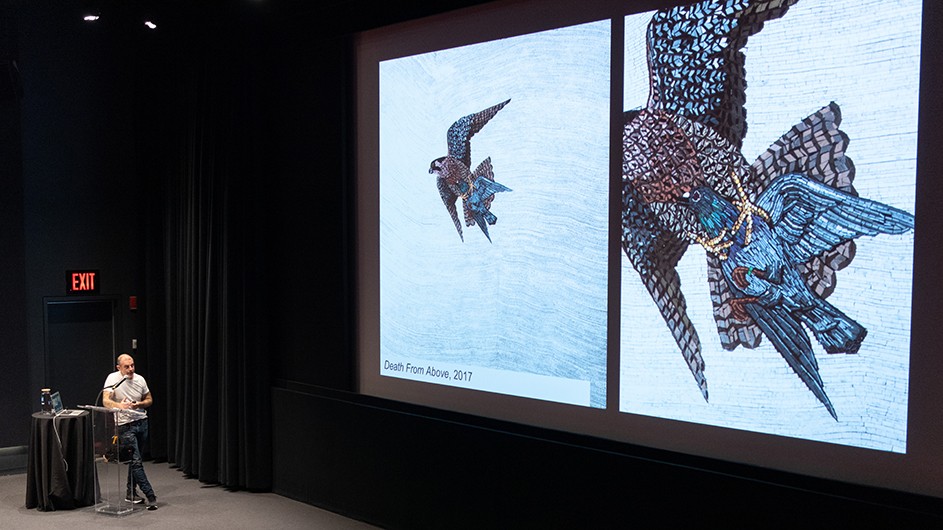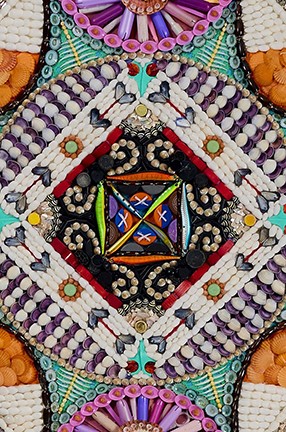Artist Duke Riley Turns Plastic Into Objects of Beauty
In a presentation at Columbia, his message about the environmental impact of plastic was loud and clear.

On November 10, 2022, the Brooklyn-based visual artist Duke Riley spoke at the Lenfest Center for the Arts about his work. The event was co-presented by the School of the Arts, the Columbia Climate School/Columbia Water Center, and Lamont-Doherty Earth Observatory.
Death to the Living, Long Live Trash
Riley began his informal career retrospective with highlights from his exhibition, DEATH TO THE LIVING, Long Live Trash, which is on view at the Brooklyn Museum through April 23, 2023. Riley uses materials collected from beaches in the northeastern United States to tell a tale of both local pollution and global marine devastation. His contemporary interpretations of historical maritime crafts—such as scrimshaw, sailor’s valentines, and fishing lures—confront the catastrophic effect that the oil, food, and beverage industries have had on the environment through single-use plastics.
Riley spoke about his fascination with urban waterways, maritime history, and the art of transgression. His work is beautiful, and often disturbing and provocative; it’s alive with humor, and the elegant double consciousness of irony. Fishing lures he’s made out of plastics culled from New York beaches, with tiny painted eyes and speckled details, are recognizable as former toothbrushes, toys, or syringes. Some have an unsettling ambiguity; viewers look closely to identify a recognizable product that made its way from a drug store to Jamaica Bay, and then became art.
Riley pointed out that the advent of the fishing lure was a significant moment in human development: People learned to deceive their prey in order to kill it. As one admires Riley’s rows of brightly colored lures made of combs, disposable razors, lighters, and eye-drop bottles, one is easily duped: “All of these things are designed in a way to entrap us,” he said.
As he leaned casually on the podium, Riley was offhand and funny. He had brought notes, which he did not use (“once I start looking at them, I’m really in trouble”), along with half a peeled orange, which he did not eat.
Museum Period Rooms Reimagined
For his exhibition, Riley took over 17th-and-18th-century period rooms at the Brooklyn Museum, decorating them with reimagined folk crafts like scrimshaw and sailor’s valentines, which he uses to reflect the modern fossil fuel industrial order.

While collecting trash on the beach, Riley came across a broken deck brush that looked like a piece of bone. Traditional scrimshaw consisted of ink drawings etched into whale bone by sailors, ornate works often created aboard whaling ships. By the 20th century, whale oil and whale bone objects were replaced by fossil fuels and petroleum-based plastics.
“I started thinking about how a lot of the people who profited from the whale oil industry ended up going into the fossil fuel industry,” Riley said. “The ones who got immortalized in scrimshaw collections were often ship captains or ship owners, or prominent society people who profited from the industry.”
The resulting art objects are repurposed detergent and spray bottles, as well as plastic containers of every description, blanched to resemble bone, and etched with portraits of CEOs and lobbyists who fight to keep us buried in single-use plastic. The designs, composed of detailed black lines, are both beautiful and sinister (that Riley is also an avid tattoo artist is no surprise).
Sailor’s valentines, another traditional folk craft, were decorative mosaics of shells contained in hinged display boxes. By layering bread bag tags, dental floss picks, straws, shells, and hypodermic needles, Riley has created his own ornate valentines, which reflect the collapsing contemporary ocean.
The Beauty of Disposable Razors
Riley remarked on how people are often surprised by the aesthetic appeal of his creations: “Wow, it’s beautiful; how did you make that out of trash?”
But the products that he has repurposed in visually pleasing ways were originally designed to be alluring. From mechanical pencils to disposable razors, “these are decisions somebody made where they were trying to make something as attractive as possible,” Riley said. “They decided what the most beautiful color for a tampon applicator was. So the idea that I’m turning it back into something people find appealing isn’t far-fetched.”
Riley showed a close-up image of one of his valentines, centered on an array of pearlescent tampon applicators in shades of lilac, mauve, and fuschia. The applicators themselves resemble shells—exceptionally pretty razor neck clams—with an iridescent plastic finish. Arranged in a fan, the applicators are surrounded by a half-moon of tiny pink spoon heads, topped with a bivalve and a bottle cap.
“In order to get that many different shades,” said Riley, “my assistants and I go through about 10,000 pounds of trash, and sort it so you can have enough variation of color to have a palette to work with. We also find a lot of pregnancy tests. They’re always negative. I think people save the positive ones.”
A Loving Tribute to Birds
An audience favorite was the flock of pigeons that Riley still keeps, the subjects and performers of some of his most beloved works, like 2016’s light show, Fly By Night. In 2013’s Trading With the Enemy, Riley trained a flock to fly Cuban Cohiba cigars from Havana to Key West, defying the U.S. embargo of Cuba, and engaging concepts of prohibition and smuggling.
Riley has created loving tributes to his birds, immortalizing them in individual painted or embroidered portraits, exhibiting their coops, along with photographs and videos of their flights. He prizes these creatures typically thought of as marginal, another instance of this artist exploring the overlooked.
Having been repeatedly told that his work was transgressive, Riley said he once looked up the definition: “I was excited to find out that there are two definitions, and the second one is a reference to water transgressing over the land.”
Any place where two things meet and interact—water and land, land and sky, trash and treasure, past and present, irony and sincerity, nature and industry—is a site of transgression. These spaces of exchange, overlap, and instability are where Riley finds the germ of his considerable imagination.
Emily Johnson is a student in the MFA Fiction Program at the School of the Arts, and will graduate in 2023.